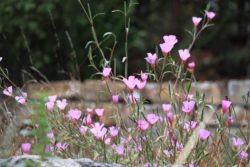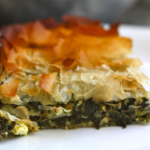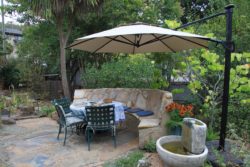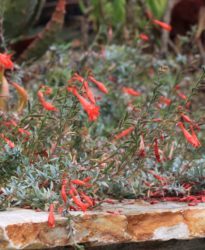Lot size: 3,500 sq. ft. back garden, 70% native
Garden Age: Garden was installed in stages, beginning in June of 2020
Years on the Bringing Back the Natives Garden Tour: New this year!
Showcase Feature
NOTE: This garden is accessed via a flight of stairs, and has sloping ground and uneven steps. It should not be visited by those with balance issues.
Like many of our gardens, Ilene’s began as a drought-tolerant landscape, planted with Mediterranean, Australian, and South African plants. Inspired by years of attending the Bringing Back the Natives Garden Tour, long-time Tour attendee Ilene had long harbored the dream of having her own garden on the Tour.
In the spring of 2020 Ilene, along with garden designers and installers Steven Cochrane and Tara Parker-Essig, began working collaboratively to re-imagine and re-plant much of the garden. They removed the sea of ivy that had engulfed a full third of the back yard and, and, in its place, created a peaceful, meandering, natural dry creek bed lined with woodland plants that thrive in the shade of the Douglas firs. An additional benefit—besides the lovely forest-y atmosphere—is that the creek bed captures rainwater, allowing it to percolate down to the aquifer, and helps to protect Temescal Creek from scouring.
The team also created a spiral garden surrounded by dry-stacked stone retaining walls which is specifically planted with only natives found naturally within five miles of the house.
Ilene’s garden journey began over two decades ago when the back yard, which had become overgrown with weeds was re-imagined. California native plants are now being consciously integrated into the more established parts of the garden that contain mainly non-native succulents and other ornamentals. Ilene noted, “The garden is constantly evolving as we incorporate natives into our mature landscape. These days, natives are the only new plants we are bringing in. The natives, started from seeds and cuttings, or bought from native plant nurseries, are used to fill in gaps and moved around if they aren’t happy.” (Note that plant labels with copper edges identify California natives, and plant labels with white edges identify non-native ornamentals.)
Wear comfortable walking shoes, and watch your footing, as some of the steps and pathways are uneven. (And do watch your head around the mature apple tree.)
This artistic, inviting, and tranquil garden contains multiple seating areas; drop down in one and rest a while—you won’t want to leave!
New! “Climate-Friendly Cooking: 111 recipes to Help Save the Planet” will be available for sale
Visit the cookbook table, browse through (and purchase!) the just-published, locally-produced cookbook, Climate Friendly Cooking—111 Recipes to Help Save the Planet, and enjoy a taste of some of its delicious recipes. The introduction to the book explains how the global food system is a major contributor to climate change; following are delicious recipes that will help you incorporate more climate-friendly and healthy recipes into your everyday life. (A percentage of the sales will go to support the Tour.)
Grant’s Glassworks: Grant Van Epps, a local glassblower who creates functional and whimsical blown glass plant stakes and marbles for use in planting containers, will have a variety of pieces for sale on the day of the tour. Check out the ones that have mini-glass mushrooms inside! (A percentage of the sales will go to support the Tour.)
Lemonade Stand: Ilene’s grandsons will be selling home-made lemonade (with proceeds going to the Lindsay Wildlife Experience, a museum and wildlife rehabilitation center in Walnut Creek)
Test your knowledge of Native Plants and Habitats – Ilene has created a mini quiz you can take as you stroll around the garden (feel free to ask for clues if needed:)
Note: Parking will be tight; park on Evirel (the cross street), not Thornhill, if possible. If you do park on Thornhill, be careful not to block the road, and look carefully before crossing the street. There will be a volunteer on-site to help guide you into a parking space, if needed.
Other Garden Attractions
• Children are welcome to entertain themselves on the play structure while you enjoy the garden (with one eye on them, of course).
• Look for the metal fish sculptures that “swim” down the creek.
• Native bent grass “lawn” is adjacent to the semi-circular seating area.
• NextDoor and the Buy Nothing Network have been sources of many of the free and low-cost materials that are found in the garden, such as the beautiful black metal arbor, flagstone, paving stones, cobble, and more.
• An admirably productive veggie garden is tucked into the sunniest part of the garden. You will also see persimmon, apple, native plum, and lemon trees.
• Check out the tidy, efficient, and attractive composting and worm bin systems that Ilene, a Master Composter (certified through Alameda County), has set up. This allows the household to most efficiently reduce and re-use kitchen and other compostable materials that would normally go into the waste system. Note: Finished compost is used mainly for the veggie and herb garden.
Gardening for Wildlife
Ilene’s office overlooks the garden, and she loves seeing and hearing the birds that visit. These include sapsuckers, woodpeckers, chickadees, hummingbirds, juncos and more. The birds are drawn in by the sound of water falling from the bubbling rock fountain, the birdbath, and the insects, berries, and seeds found in this wildlife-friendly haven. Butterflies flit through the garden, and native bumble and carpenter bees buzz by. Lizards bask on the boulders, and salamanders can be found in a natural habitat created by logs. And, very recently, a red-breasted nuthatch has been building a nest in the mature elderberry tree – see if you can spot the action!
Garden Talks
11:00 “How to select understory plants for a coastal forest setting” by Steven Cochrane, FCI Fine Gardening
12:00 “Got clay? Learn to understand, love, and use it to your advantage” by Tara Parker-Essig, Restoration Gardening
1:00 1:00 “Conscious integration of California natives into an existing landscape” by Lupe Peru, Alegre Landscaping & Design
Keystone species (watch this talk by Doug Tallamy!)
Keystone species—our own, local ecological powerhouse plants— in this garden include Douglas fir, maples, California lilac, manzanitas, dogwood, huckleberry, gooseberry, thimbleberry, pink-flowering currant, native strawberry, and (native, of course!) sunflowers.
At least partially wheelchair accessible? No
Wondering what to make for dinner? Try this great recipe!
Moosewood Cookbook Spanakopita
Note from Ilene, who provided this recipe: “The spanakopita recipe from the original Moosewood Cookbook has been one of my favorite go-to recipes ever since I first discovered this vegetarian classic back in my college days in New York. I learned how to properly work with filo dough when I worked in a Greek restaurant, and having that skill definitely helped me master this recipe. But of course that was way before YouTube videos (which now provide endless opportunities to learn this delicate but definitely manageable skill). For added interest and texture, I like to add finely chopped walnuts or pinenuts between layers of filo (every 4-5 layers). An excellent dish for a group, this recipe makes a generous 8 servings.”
Spanakopita













